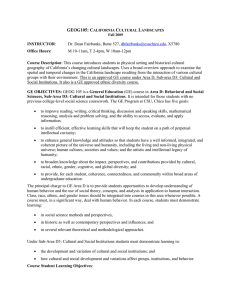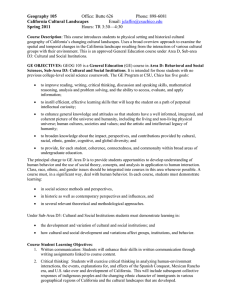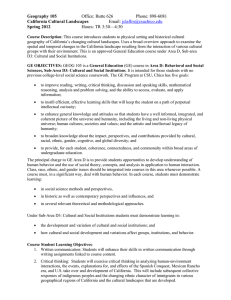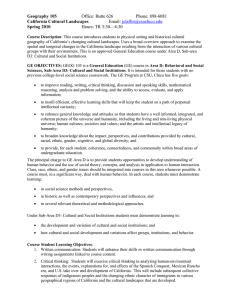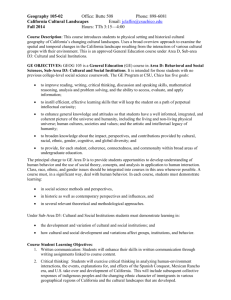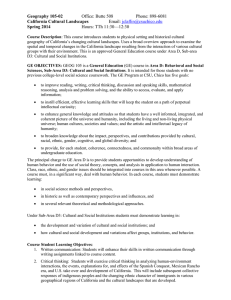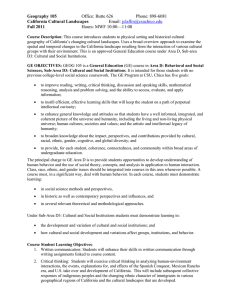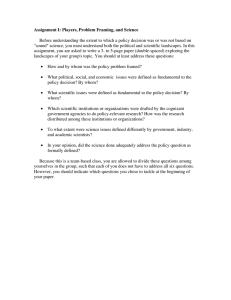1 Instructor: Dr. D. J. O’Donnell Office: Tehama 227
advertisement
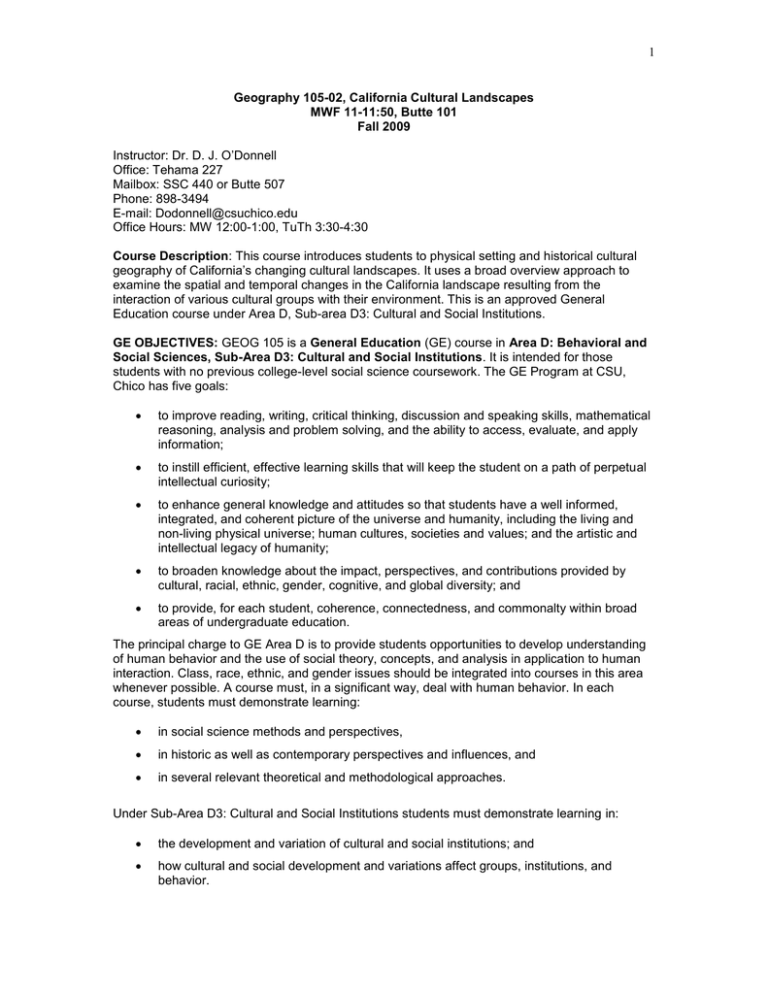
1 Geography 105-02, California Cultural Landscapes MWF 11-11:50, Butte 101 Fall 2009 Instructor: Dr. D. J. O’Donnell Office: Tehama 227 Mailbox: SSC 440 or Butte 507 Phone: 898-3494 E-mail: Dodonnell@csuchico.edu Office Hours: MW 12:00-1:00, TuTh 3:30-4:30 Course Description: This course introduces students to physical setting and historical cultural geography of California’s changing cultural landscapes. It uses a broad overview approach to examine the spatial and temporal changes in the California landscape resulting from the interaction of various cultural groups with their environment. This is an approved General Education course under Area D, Sub-area D3: Cultural and Social Institutions. GE OBJECTIVES: GEOG 105 is a General Education (GE) course in Area D: Behavioral and Social Sciences, Sub-Area D3: Cultural and Social Institutions. It is intended for those students with no previous college-level social science coursework. The GE Program at CSU, Chico has five goals: to improve reading, writing, critical thinking, discussion and speaking skills, mathematical reasoning, analysis and problem solving, and the ability to access, evaluate, and apply information; to instill efficient, effective learning skills that will keep the student on a path of perpetual intellectual curiosity; to enhance general knowledge and attitudes so that students have a well informed, integrated, and coherent picture of the universe and humanity, including the living and non-living physical universe; human cultures, societies and values; and the artistic and intellectual legacy of humanity; to broaden knowledge about the impact, perspectives, and contributions provided by cultural, racial, ethnic, gender, cognitive, and global diversity; and to provide, for each student, coherence, connectedness, and commonalty within broad areas of undergraduate education. The principal charge to GE Area D is to provide students opportunities to develop understanding of human behavior and the use of social theory, concepts, and analysis in application to human interaction. Class, race, ethnic, and gender issues should be integrated into courses in this area whenever possible. A course must, in a significant way, deal with human behavior. In each course, students must demonstrate learning: in social science methods and perspectives, in historic as well as contemporary perspectives and influences, and in several relevant theoretical and methodological approaches. Under Sub-Area D3: Cultural and Social Institutions students must demonstrate learning in: the development and variation of cultural and social institutions; and how cultural and social development and variations affect groups, institutions, and behavior. 2 Course Student Learning Objectives: 1. Written communication: Students will enhance their skills in written communication through writing assignments linked to course content. 2. Critical thinking: Students will exercise critical thinking in analyzing human-environment interactions, the events, explanations for, and effects of the Spanish Conquest, Mexican Rancho era, and U.S. take over and development of California. This will include subsequent collective responses of indigenous peoples and the changing ethnic character of immigrants in various geographical regions of California and the cultural landscapes that are developed. 3. Students will demonstrate enhanced factual knowledge of the development over time and space of the physical geographic landscape and subsequent interactions with sociocultural characteristics of pre-Colombian, Spanish conquest, Mexican Rancho era, U.S. colonialism and contemporary California. 4. Students will be able to describe the predominant cultural patterns over time and space, and inter-ethnic relations between cultures and the regional/local societies in which they exist. Course audience: This course is an approved General Education course for both Area D3 and for Diversity (Ethnic) requirement. Readings and Reference Textbook (required): Fairbanks, D.H.K. (2009). California Cultural Landscapes: An Exploration of Spatial and Temporal Patterns. 1st ed., Kendall-Hunt Press, Dubuque, IA. Blackboard Vista: readings and assignments Internet: Atlas of CA: http://www.humboldt.edu/~cga/calatlas/index.html WEEK 1 8/24-28 2 8/31-9/4 3 9/7-11 4 9/14-18 5 9/21-25 6 9/28-10/2 7 10/5-9 8 10/12-16 9 10/19-23 10 10/26-30 TOPICS Course Introduction, Concepts in Geography, Cultural Landscapes, Critical Reading Practices Landforms: Shapes and Materials, Plate tectonics, Geologic Natural Hazards Map Quiz: Landforms 9/7 Labor Day—Campus Closed Climate: Elements and Controls, Climate Regions, Atmospheric Natural Hazards Natural Vegetation, Ethnicity and the Environment, Native American Landscapes Spanish Arrival and Mission Era pollution Exam 1 Mexical culture: The Mexican Rancho Era, Gold Rush: the World Rushes In, US Take Over Ethnic Conflict in Gold Period, Environmental Conditions-hydraulic mining, natural resource law, Water law, The Legacy of the Homestead Act Map Quiz: Rivers and Lakes Managing Federal Lands, Transportation and Settlement, 19th Century Search for the Ideal Landscape (John Muir) Map Quiz: Counties Rise of Southern California Myths, Arroyo School, California Architecture-North vs. South EXAM 2 Reclamation in California, California Agriculture, READINGS/ASSIGNMENTS Text: Ch.1 Text: Ch.2 Exercise: Location Text: Ch.3 Exercise: Landforms Text: Ch.4. 5 Exercise: Climate Text: Ch.6 Text: Ch.7 Text: Ch.8 Text: Ch.9 Text: Ch.9 Text: Ch.10 3 11 11/2-6 12 11/9-13 13 11/16-20 14 11/23-27 15 11/3012/4 16 12/7-11 Final Exams 12/14-18 Irrigation Agricultures: Japanese, Filipinos, Mexicans Map Quiz: Cities Family Migration Paper Due Factories in the Fields, Dust Bowl and Great Depression, “Okie” Cultural Landscapes 11/11 Veterans Day—Campus Closed World War II: Industry and Immigration, Urban Encroachment, Urban Water Imperialism Taming the Colorado River, Sacramento Valley Flood Control, Central Valley Project, State Water Project, Energy Map Quiz: Water Delivery THANKSGIVING VACATION Mexican Re-conquest, “Mexical-Mexamerica”, Modern Asian Immigration, The African-American Experience Recent Refugees, Contemporary Urban Landscapes, Environmental issues, California Futures…. Final Review Our exam is Monday, 12:00-1:50 in Butte 101 Text: 10 Text: Ch.11, 12 Exercise: Ethnic Settlement Text: Ch.11, 12 Text: Ch.12 Exercise: The Californios Text: Ch.12 GRADING POLICY: The final course grade is based on the total number of points earned. As a general rule, 90% = A, 80% =B, 70% = C, 60% = D, and less than 60% = F. GRADING: The course grade will be based on exams, the Family Migration Paper, quizzes, and other assignments. The points for each will be announced. STUDENTS, YOU ARE EXPECTED TO: Be current with the reading. Turn in assignments on or before the due date. Late papers are accepted but will have their grades reduced by 20% for each weekday (not class period) they are late. Ask when in doubt, and consult with the instructor if your exam or writing assignment grades are low. There will be no “extra credit.” Notify the instructor if you have special needs. Put an appropriate amount of effort into the writing assignments, commensurate with collegelevel work. This means following the research and writing guidelines and attending to standard rules of composition and grammar. Consult a style manual if needed. Pay attention to corrections made on returned papers and make each paper better than the previous one. Non-native English speakers are expected to get help with their written English, if needed. Visit the Student Learning Center, SSC 340, 898-6839, if help is needed in study skills or writing.. IMPORTANT: It is a discourtesy and a distraction to the other class members as well as to the instructor to leave the room during class, unless there is an emergency. If you know you will have to leave early, notify the instructor beforehand. Video clips are an important part of the course. You are not free to leave during videos, unless you have a compelling reason. Don’t use them as routine bathroom breaks. Turn cell phones off and keep them put away during class.
